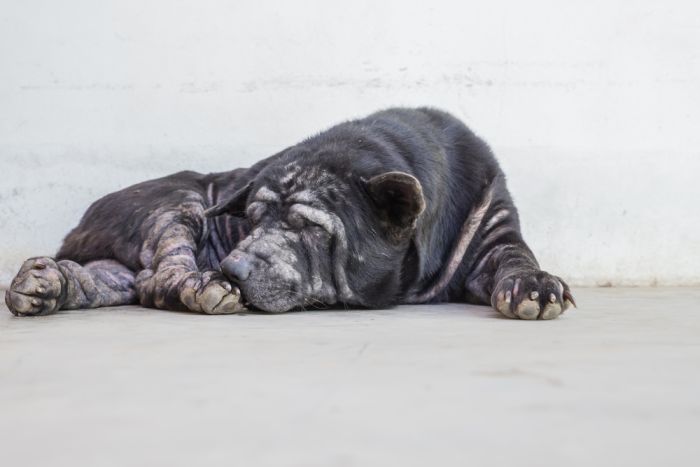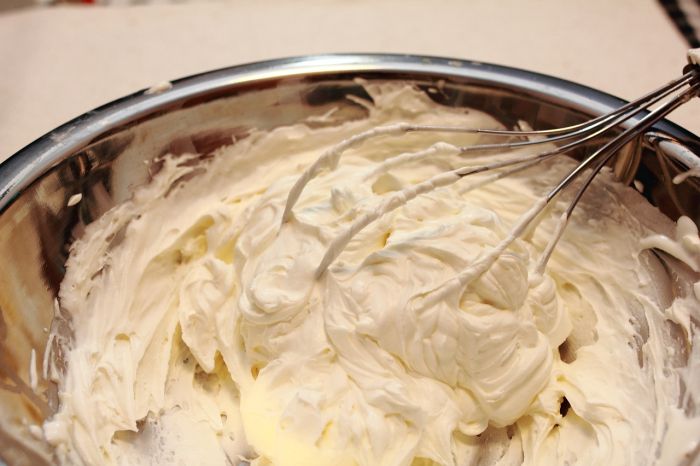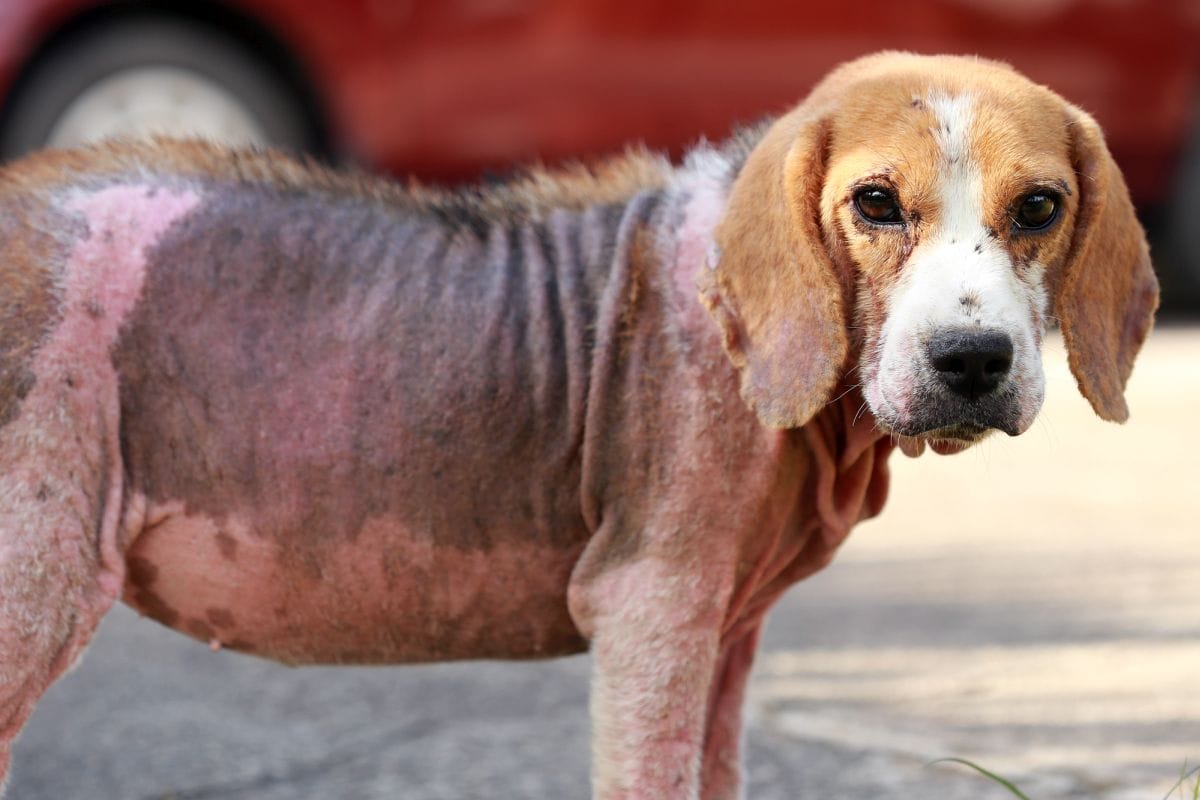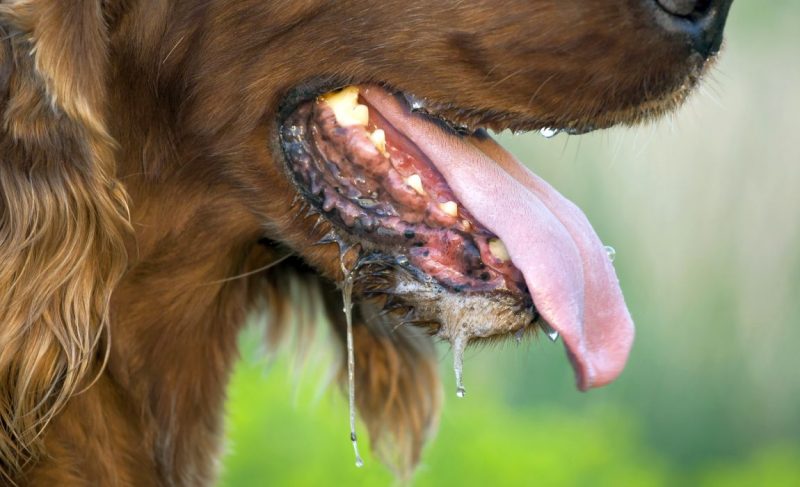Mange is a very troubling health problem that can make your dog miserable.
It not only causes some of the most intense itchiness imaginable, but it can also lead to secondary skin infections and other problems.
In fact, if you don’t address the issue promptly, you could wind up suffering from the arthropods who cause mange yourself.
Fortunately, there are a number of mange treatments available that’ll put an end to the problem and help your pup feel better. Some of these treatments will require you to visit your vet, but there are also a few over-the-counter products and home remedies you can try.
We’ll explain the basics of mange, outline the general treatment strategy, and share some of the best treatments and remedies below.
What Is Dog Mange?
Mange is a disease caused by microscopic mites living on your dog’s skin. There are a few different types of mange, and we’ll discuss each below.
Demodectic Mange
Demodectic mange is an irritating skin condition caused by mites of the genus Demodex.
Most dogs have Demodex mites living on their skin (they actually inhabit the hair follicles of your dog’s skin), and they usually don’t cause any problems. Problems occur when sick, old, or very young dogs are not able to mount a sufficient immune response to the tiny bugs, which allows their population to explode.
Demodex mites typically cause problems for young puppies, who usually contract them from their mother. Demodectic mange can occur in small, localized areas — often around the eyes and paws — or it can affect most of your dog’s body.
Sarcoptic Mange
Sarcoptic mange (which is also called scabies) is caused by sarcoptic mites. Sarcoptic mange mites are not normal parts of your dog’s skin fauna, so when they are present, they typically cause problems. Unlike Demodex mites, which live in the hair follicles, sarcoptic mites burrow into your dog’s skin.
Sarcoptic mites are highly contagious, and they may infect any warm-blooded critter – even healthy adults. Sarcoptic mange mites may cause localized problems (most commonly on the ear flaps, elbows, or belly), but they can quickly colonize your dog’s entire body.
Cheyletiella Mange
There is one other type of mite that can cause mange-like problems for dogs. Known as Cheyletiella yasguri, this mite causes a condition known as Cheyletiellosis or “walking dandruff.”
This condition rarely causes the intense itching that other types of mange do, and the mites are often easy to eradicate with over-the-counter, topical flea treatments.
Accordingly, we’ll primarily be focusing on sarcoptic and demodectic mange below.
Symptoms of Dog Mange
Both sarcoptic and demodectic mange typically present similar symptoms. Some of the most common include:
- Hair loss
- Red, irritated skin
- Scaly or scabby skin
Sarcoptic mite infestations often cause intense itchiness too, although this isn’t common with demodectic mite infestations.
Mites typically prefer to feed on areas of your dog’s body that have relatively little hair, such as the elbows, armpits, and abdomen. The ear margins are also one of the most common sites that owners notice symptoms of mange – particularly in the case of sarcoptic mites.
Potential Complications of Mange
There are a few complications that mange can cause if it isn’t treated promptly. We’ll discuss two of the most notable complications below.
Bacterial and Fungal Infections
The intense itching that accompanies mange will cause most dogs to scratch incessantly. This can irritate your dog’s skin and allow bacterial and fungal infections to occur, which will complicate the treatment process.
In a worst-case scenario, your dog may need antibiotics or antifungal medications to eliminate these types of infections.
Zoonotic Potential
While Demodex mites can be transmitted to people, they won’t cause you any health problems. You won’t even know they’re there, and you probably already have them on your body (enjoy that nightmare fuel).
But sarcoptic mange mites can be transmitted to people, where they’ll typically cause pretty significant issues. Sarcoptic mange mites cause the same kinds of problems in people – most notably intense itchiness – that they do in dogs.
Your doctor can prescribe medicines to help eliminate the bugs from your skin, but it’s better to simply treat your dog promptly before the mites can colonize the human members of the household.

The Best Course of Action For Mange? Visit Your Vet
The best thing to do if you suspect your dog is suffering from mange is to pick up your pooch and head over to the vet’s office.
For starters, your vet may be able to verify that the problem is, in fact, mange (several other skin ailments can cause very similar symptoms). In some cases, a physical examination may be all that’s required for your vet to be confident in a diagnosis of mange, but skin scrapings or hair plucks (in the case of demodex mites) can also be collected to provide further evidence.
Then, assuming that mange is the problem, your vet can prescribe medications that will quickly and easily eliminate the problem.
In fact, several medications can be used to eliminate mange. Some of the most common include:
- Amitraz
- Imidocloprid
- Slamectin
- Sarolaner
- Fluralaner
- Alfoxolaner
If none of those prove effective, your vet may recommend ivermectin injections or an ivermectin-based flea treatment (although ivermectin isn’t safe for use in collies and some other herding breeds).
Milbemycin may also be prescribed in some cases, although this represents “off-label” use.
In addition to providing you with the best available treatments for mange, your vet can treat any bacterial or fungal infections that result from the mite infestation.
Over-the-Counter Mange Treatments
If you are unable to obtain a mange medication or shampoo from your vet, you may want to consider purchasing an over-the-counter mange treatment for your pet.
Most such products contain ingredients like coal tar or sulfur, which often help to kill the mites living on your dog’s skin and resolve the problem.
There are basically three different types of over-the-counter mange treatments available. We’ll discuss each type below.
1. Mange Shampoos
We’ve discussed the best shampoos for dog mange before, so give it a read to learn how mange shampoos work.
However, if you just want to cut to the chase, we think that SynergyLabs Antiparasitic & Antiseborrheic Medicated Shampoo is the best dog shampoo available for mange and recommend it strongly.
- GENTLE SOOTHING – Helps promote a healthy skin and coat free of flaky, dry, or overly oily skin...
- FAST ACTING – Works fast with powerful ingredients that help shed dry skin and hydrate your pet's...
- VET-RECOMMENDED – This paraben, dye, and soap-free pet shampoo has gentle cleansers and is made...
- FORMULATED FOR DOGS – Specifically formulated for dogs, this pH-balanced shampoo is unlike human...
SynergyLabs Medicated Shampoo contains coal tar and sulfur to kill the mites, as well as things like salicylic acid and oatmeal to help exfoliate and moisturize your dog’s skin.
It’s also gentle and unlikely to irritate your dog’s skin like some other medicated shampoos, as it is made without any parabens, dyes, or soaps.
2. OTC Mange Medications
There are a few over-the-counter mange medications available that you may want to consider.
Most OTC mange medications are made with various plant oils and are unlikely to help treat your dog’s mange. However, at least one product – Happy Jack Sarcoptic Mange Medicine – contains sulfur and appears to be effective in many cases.
- FEDERALLY APPROVED OTC TREATMENT FOR MANGE. Through rigorous testing requirements and application,...
- THE ORIGINAL! SINCE 1946. The founder of Happy Jack created this original solution for his beagles...
- SOOTHES IRRITATED SKIN. Effectively relieves itching from severe mange, fungi, falling hair, itching...
- FAST-ACTING FORMULA ON STUBBORN CASES. Works within just a few days! Happy Jack relieves the most...
You’ll need to be careful using Happy Jack Mange Medicine and avoid getting it in your pet’s eyes. It is also wise to try this medication out on a very small area of your dog’s skin before treating his entire body, to be sure that it won’t irritate his skin.
3. Flea Treatments
A few prescription flea treatments are effective at killing mange mites, but one over-the-counter flea treatment — Frontline Plus – is also worth considering for additional mange-fighting properties.
- Keep your dog protected from fleas & ticks all month long with FRONTLINE Plus for Dogs a...
- Break the flea life cycle with FRONTLINE Plus. Specially formulated with fipronil and (S)-methoprene...
- Trusted by pet owners for over 20 years, FRONTLINE Plus for Dogs can be used on puppies as young as...
- FRONTLINE Plus also comes in a formula designed for cats and kittens eight weeks of age and older,...
Frontline Plus is a fipronil-based topical medication that is primarily intended as a flea and tick treatment, but it may help to control mite infestations too.
Note that Frontline Plus doesn’t claim to treat mange, but other fipronil-based treatments (specifically, spray-on varieties of fipronil) have been shown to be effective in eliminating sarcoptic mites. So, you probably should view Frontline Plus as one component of a comprehensive mange-treatment strategy.
Besides, your dog needs an effective flea and tick treatment anyway, so there’s little to be lost by trying Frontline Plus.
Home Remedies for Dog Mange
If veterinary care isn’t immediately available, and none of the over-the-counter treatments listed above seem appropriate for your pet, you may want to try a popular home remedy.
We’ll discuss some of the most commonly recommended home remedies below, but it is important to understand that many are unlikely to help. Some may even present health risks for your pet.
Accordingly, it is imperative that you use great care when employing any of these strategies.
1. Olive Oil

Some owners have had success in treating very mild cases of localized mange with olive oil. Just apply a thin layer of the oil to the affected areas of your dog’s skin.
The oil may smother any mites present, and it’ll also help to re-moisturize your dog’s skin and quell your dog’s non-stop itchiness.
But while this treatment may provide some value for very minor cases of localized mange, it won’t provide any help for dogs who are battling body-wide infections (plus, coating your dog’s entire body in olive oil would not only be expensive, it would create an enormous mess all over your home).
Whether it ends up being effective or not, olive oil is probably one of the best home remedies to try, as it is completely harmless (although dogs who consume a significant amount may experience some intestinal issues), and it is readily available.
The biggest problem you’ll have is preventing your dog from simply licking it off.
2. Aloe Vera

Some dog owners have used extracts from the Aloe vera plant to treat mange. Aloe vera extract helps to soothe the skin, reducing the itchiness and irritation that mange mites cause. It also exhibits some mild antibacterial qualities, which may help prevent infections from setting in.
Some sources claim that Aloe vera extracts also kill ectoparasites, but we’ve been unable to find any reputable source that verifies this claim. However, just about any thick liquid, gel, or paste, may suffocate mites living on your dog’s skin, so it is plausible.
Aloe vera extracts are generally applied to the infected areas a few times a week until the mange clears up. Consequently, like the olive oil treatment, this is a home remedy that is only suitable for localized mange infections.
It’s also important to note that Aloe vera extracts are toxic to dogs, so you’ll need to prevent your pet from ingesting the substance – this is obviously easier said than done. You may have to fit your dog with an e-collar during this time.
Typically, dogs who eat Aloe vera suffer from vomiting or diarrhea, but in some cases, depression and muscle tremors may also occur.
3. Yogurt

Yogurt is another popular home remedy for mange. Most owners who use it to treat mange just slather it on the affected area (obviously, this isn’t a good idea for pups suffering from systemic mange).
Like olive oil, plain, unsweetened yogurt is safe for dogs; in fact, it is actually full of naturally occurring probiotics, so it’s no big deal if your dog licks the yogurt off his skin.
If yogurt proves effective, it’ll likely be because it smothers most of the mites on your dog’s skin. It probably helps moisturize the skin a little, and the probiotics it contains may help eliminate fungi living on your dog’s skin, but this has yet to be empirically demonstrated.
Accordingly, there’s no reason you can’t try yogurt on dogs suffering from mild, localized cases of mange. It may not work, but it shouldn’t cause many serious problems.
4. Lemon

Various lemon juice and water mixtures are sometimes recommended for treating mange in dogs. They’re usually applied topically to the affected area.
Different sources recommend using different amounts of lemon juice, but you’re usually looking at a whole lemon or two in a liter or two of water. Sometimes, these mixtures are infused with garlic.
Ostensibly, the acidity of the resulting mixture will kill the mites living on your dog’s skin. It may also help to eliminate some of the bacteria or fungi present – many citrus fruits are known to have antiseptic properties.
However, there’s a big difference in the way lemon juice works in a petri dish and how it’ll work on your dog’s skin, so it may or may not have the intended effect.
While lemon juice isn’t toxic, and your dog isn’t likely to ingest very much, it may irritate your dog’s skin. It could even exacerbate skin problems, as it’ll likely kill off many of the beneficial bacteria living on your dog’s skin.
We’d generally discourage owners from trying this particular home remedy.
5. Honey

Honey is another common home remedy for mange. Like many of the other substances used in these home remedies, honey is pretty safe, and it is even included in some dog foods.
Honey has a number of antifungal and antibacterial properties, so it may help combat infections, and the thick nature of the liquid will likely smother the mites living on your dog’s skin (at least in small areas).
From a health and safety perspective, it’s probably one of the safest home remedies for mange that dog owners employ.
But that doesn’t mean covering your dog’s skin in honey is a great idea. For one thing, your dog will probably twist himself in knots trying to lick it off, as most dogs find honey pretty tasty. Also, it’ll likely make your dog stickier than duct tape, which will cause dust and debris to adhere to his skin.
6. Apple Cider Vinegar

Some owners try to treat mange by applying apple cider vinegar to their dog’s skin or by adding it to their water bowl.
The mechanism by which this purportedly kills mange mites is rarely discussed, but the acidity of the solution is likely responsible for any positive results observed.
Pour some vinegar on a petri dish full of mange mites and it’ll probably kill the bugs, but once again, there’s a big difference between a petri dish and your dog’s skin. Besides, you could probably just drown mites in a petri dish with water, but this won’t work on your dog’s body.
Frankly, administering apple cider vinegar orally is really unlikely to help your dog’s mange in any way. Topical application may provide some value, but it is unlikely to help as much as proper mange medications.
Apple cider vinegar is often regarded as a “miracle” cure for everything from bacterial infections to acid reflux, but there just isn’t a lot of empirical data that backs these assertions.
It probably is helpful for treating some problems – particularly skin problems brought on by high pH levels – but it is highly unlikely to be the miracle cure it’s often described as.
In small quantities, apple cider vinegar probably won’t sicken your dog, but it may irritate his skin, especially if applied in non-diluted form.
A Common, But Dangerous, Home Remedy: Borax Dips
Homemade borax-based dips are often recommended for treating mange in dogs. And while these are likely more effective than some of the other common home remedies, they are not a good idea.
In fact, we’re not even going to share a recipe for these types of dips, as they’re potentially dangerous.
Borax is a laundry detergent that probably is pretty effective at killing mites. In fact, borax-based solutions may be great for killing mites on inanimate objects or floors.
However, borax is very toxic when ingested. In a best-case scenario, it’ll only cause your dog to suffer gastrointestinal distress, but it can also cause seizures or death if your dog eats too much.
Additionally, borax is extremely drying to the skin. This will make your dog’s skin even more irritated than before, and it’ll likely increase the chances that your dog will suffer from a bacterial or fungal infection.
Hygiene for the Whole House
It’s important to note that sarcoptic mites may not be living just on your dog; they’ll also end up infesting your dog’s bedding (demodectic mites don’t spread in this fashion). In fact, they may even wind up in your bed, couch, or carpets.
So, if you want to ensure your dog’s treatment is effective and reduce the chances of the mites spreading to the human members of your family, you’ll want to clean your home from top to bottom when dealing with canine mange.
Be sure to wash all of your linens in hot water and run them through the dryer on a high-heat setting to kill any of the little buggers living in your sheets and blankets.
Use a steam cleaner on your carpets to help kill any bugs living in the carpet fibers and replace or wash couch cushion covers and other fabrics that may have become infested.
***
Clearly, the wisest course of action is to solicit your veterinarian’s help anytime your dog suffers from mange. Not only will your vet be able to eliminate the mites quickly and easily, he or she will also be able to treat any secondary infections that may occur.
However, if you find yourself in a situation in which veterinary care is not available, you may want to try some of the over-the-counter treatments or home remedies discussed above. Just be sure to keep your pup’s health and well-being at the front of your mind and be ready to visit your vet if they don’t work.
Have you ever had to treat your mutt for mange? What kind of remedy did you use? We’d love to hear about your experiences in the comments below!












Leave a Comment